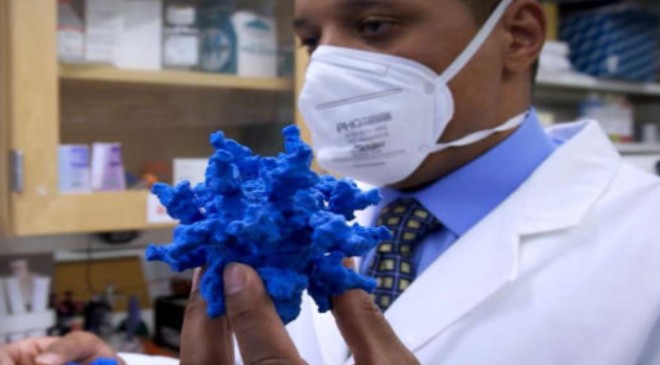Scientists are working to develop a “pan-coronavirus” vaccine — one that offers protection against multiple variants of the coronavirus that causes Covid-19.
The hope is that such a vaccine could pave the way for the development of a universal coronavirus vaccine, which could head off any coronavirus — not only emerging variants that cause Covid-19, but also some common colds and even the menacing threat of novel coronaviruses we haven’t identified yet.
But such vaccines are “going to take years to develop,” Dr. Anthony Fauci, director of the National Institute of Allergy and Infectious Diseases, said during a White House briefing on Wednesday.
Coronaviruses that infect humans were first identified in the mid-1960s, and there are seven known human coronaviruses: four that cause common colds; Middle East respiratory syndrome, or MERS; severe acute respiratory syndrome, or SARS; and SARS-CoV-2, the coronavirus that causes Covid-19.
“However, since September of 2020, there have been five SARS-CoV-2 variants of concern: Alpha, Beta, Gamma, Delta and now the current Omicron,” Fauci said in Wednesday’s briefing.
“So obviously, innovative approaches are needed to induce broad and durable protection against coronaviruses that are known and some that are even at this point unknown,” Fauci said. “Hence, the terminology ‘pan-coronavirus vaccine.’ “
Universal vaccine could help fight variants
During the Covid-19 pandemic, the world has seen several coronavirus variants emerge — and with some, the effectiveness of current coronavirus vaccines to protect against infection and illness has slightly diminished.
However, public health officials emphasize that it’s still important to get vaccinated now.
The current coronavirus vaccines authorized for emergency use or approved in the United States — from Pfizer/BioNTech, Moderna and Johnson & Johnson — were developed to target the original wild-type SARS-CoV-2 virus identified at the start of the pandemic.
Although those vaccines have shown effectiveness against infection and illness of around 90% and higher against the wild-type, that effectiveness against some SARS-CoV-2 variants has seen a small dip, dropping to 66% against Delta infections, for instance, and even lower for Omicron. But a third dose of the vaccine — or a booster shot — can improve protection against variants.
“Our current vaccine regimens do provide strong protection, particularly when used with a booster, against severe coronavirus disease and death,” Fauci said Wednesday. “So do not wait to receive your primary vaccine regimen, and please get your booster if you are eligible.”
A universal coronavirus vaccine — or even just a pan-coronavirus vaccine — could shift the strategy entirely.
NIAID, part of the National Institutes of Health, has invested at least $1.2 billion in coronavirus vaccine research, including multiple projects on developing pan-coronavirus vaccines. In September, NIAID announced awards of about $36.3 million to three academic institutions — the University of Wisconsin, Brigham and Women’s Hospital in Boston and Duke University — to study and develop vaccines to protect against multiple types of coronaviruses and variants.
“I don’t want anyone to think that pan-coronavirus vaccines are literally around the corner in a month or two. It’s going to take years to develop in an incremental fashion,” Fauci said during Wednesday’s White House briefing. “Some of these are already in Phase 1 clinical trials.”
How to build a vaccine that fights multiple coronaviruses
In the heart of Durham, North Carolina, on Duke University’s campus, sits the Duke Human Vaccine Institute. The scientists there make up just one of many research teams around the world attempting to create a pan-coronavirus vaccine.
What we try to do is really target a specific part of the virus, for instance, that we know is its Achilles’ heel,” Kevin Saunders, director of research at the Duke Human Vaccine Institute, told CNN Chief Medical Correspondent Dr. Sanjay Gupta this week.
For a vaccine to work across different types of coronaviruses, that “Achilles’ heel” should be a part of the virus that stays uniform across variants and over time — so as viruses mutate, the part that the vaccine targets probably won’t change much.
This “Achilles’ heel” also should be something that a virus needs. In the case of coronaviruses, that could be a part of the virus that it uses to bind to our cells when it infects us.
“Typically, that’s a place where the virus is binding to specific protein on the host cell that it’s targeting, and if it changes that site, then it’s no longer able to infect,” Saunders said. “And that usually is constrained evolutionarily by that virus, because if it loses that site, then it’s no longer able to infect.”
Once that part of the virus — the “Achilles’ heel” or “conserved site” — is identified, the vaccine can work by eliciting antibody responses against it. The hope is for that site, or the Achilles’ heel, to be present on more than one virus.
“We try to find antibodies that bind to conserved sites, and so what that means is, we go into individuals that have been infected with a particular virus, and we start mining their immune response to understand what’s effective and what’s not effective,” Saunders told Gupta.
“One of the things we found, especially in SARS-CoV-2, is that there’s antibodies that can specifically target sites that are conserved or present on multiple different coronaviruses, and so once you know about those types of sites, then you can start to say, ‘How do I design a vaccine that focuses in on that?’ ” Saunders said. “That’s now what we’re doing for SARS-CoV-2.”
One clue about such a site arose when Saunders and his colleagues found an antibody called DH1047. They identified that antibody after analyzing the blood of a person who had SARS in 2003 and found that the antibody has the ability to bind to both SARS-CoV-1, which causes SARS, and SARS-CoV-2, which causes Covid-19.
“So we took that antibody as a template to say, ‘there must be some site that’s common between SARS-CoV-1 and SARS-CoV-2, and let’s figure that out, because if we can figure out that conserved or common site, then we would know that needs to be in the vaccine.’
“And so we found that antibody. We then solved the structure, meaning that we figured out exactly where it binds on SARS-CoV-2 and SARS-CoV-1, and then we used that as our vaccine concept,” Saunders said. “When we vaccinated non-human primates with our vaccine, they then generated these antibodies that look like DH1047.”
The approach at Duke University, to focus on DH1047, is just one of many strategies among scientists working to develop pan-coronavirus vaccines. Some other approaches to creating a broadly protective vaccine involve inducing multiple types of antibodies and may not rely on a single conserved site.
But overall, vaccine research in animals has generated the types of antibodies that could offer protection against multiple coronaviruses.
Another investigational pan-coronavirus vaccine, being developed at the Walter Reed Army Institute of Research in Silver Spring, Maryland, was found in preclinical trials to protect non-human primates from disease caused by the original strain of SARS-CoV-2 and to induce antibody responses against major SARS-CoV-2 variants of concern and the SARS-CoV-1 virus that emerged in 2002, the Military Health System announced in late December.
The vaccine is being studied in humans; it entered Phase 1 human trials in April.
This isn’t the first time scientists have tried to develop universal vaccines that could offer protection against multiple viruses.
Scientists at the National Institutes of Health’s NIAID influenza research program have been working to create a universal flu shot, which the program describes as a vaccine that provides robust, long-lasting protection against multiple subtypes of flu, rather than a select few. Studies are still underway.
Separately, researchers at the Duke Human Vaccine Institute have been working to develop a universal vaccine against HIV, the human immunodeficiency virus that causes AIDS. They have identified an antibody that could play a role in developing such a vaccine, but that research is also ongoing.
As for investigational pan-coronavirus vaccines, if Duke’s, the military’s or any others prove successful in human trials, they could be on their way to becoming the Covid-19 shot we receive in the coming years — to protect against emerging variants or even an unknown coronavirus that might spill over from animals to humans.
“How I see it playing out for a universal coronavirus vaccine would be that we have a vaccine that’s effective against the seven human coronaviruses. So this means that the vaccine could prevent the coronaviruses that currently are known to infect humans,” Saunders told Gupta.
“We would then move over to the viruses that are able to infect human cells but are circulating in animals — because we believe those are the next likely candidates to move over and cause a novel coronavirus pandemic,” he said. “I would think of it as that kind of tiered approach: Can we stop what’s currently infecting humans? Can we stop the next likely candidates? And then can we attack the reservoirs that could give rise to novel coronaviruses?”
The goal should be to think about a universal coronavirus vaccine’
To establish what the future of Covid-19 vaccines might look like, US health regulators will need to determine what their goal is with the vaccines: to prevent serious illness and hospitalizations, or to prevent infections overall and spread of disease, Dr. Amesh Adalja, senior scholar at Johns Hopkins University Center for Health Security, told CNN last week. The emergence of new variants, waning immunity and vaccine efficacy are among other factors that could play a role.
“Is the goal to prevent serious illness, hospitalization and death? And if that’s the goal, the current vaccines are holding up really well in most populations at that task. Outside of the immunocompromised, there really isn’t a compelling need for boosters for protection against serious disease,” Adalja said.
“However, there are others who may have goals about transmission and blocking transmission, and there’s an argument that maybe we need second-generation vaccines,” he added. “Ones that provide more durable immunity. Ones that are more universal.”
These “second-generation vaccines” include both the variant-specific vaccines and a possible universal coronavirus vaccine.
“But any time that you’re designing variant-specific vaccines — and this is very reminiscent of the flu vaccine process — you’re always going to be kind of in a reactive posture, waiting for what the virus does and then responding to that,” Adalja said. “Whereas if you could come up with a universal coronavirus vaccine — just like a universal flu vaccine — that was able to target a part of the virus that doesn’t mutate, you would really be in a proactive stance to take a lot of these variants off the table.
“So I think that the goal should be to think about a universal coronavirus vaccine, one that protects against SARS-CoV-2 but also against the four coronaviruses that cause 25% of our common colds,” he said. “I think that’s where we want to aim, and there is some data that the universal coronavirus vaccine is possible, and there’s one making its way through clinical trials.”









































